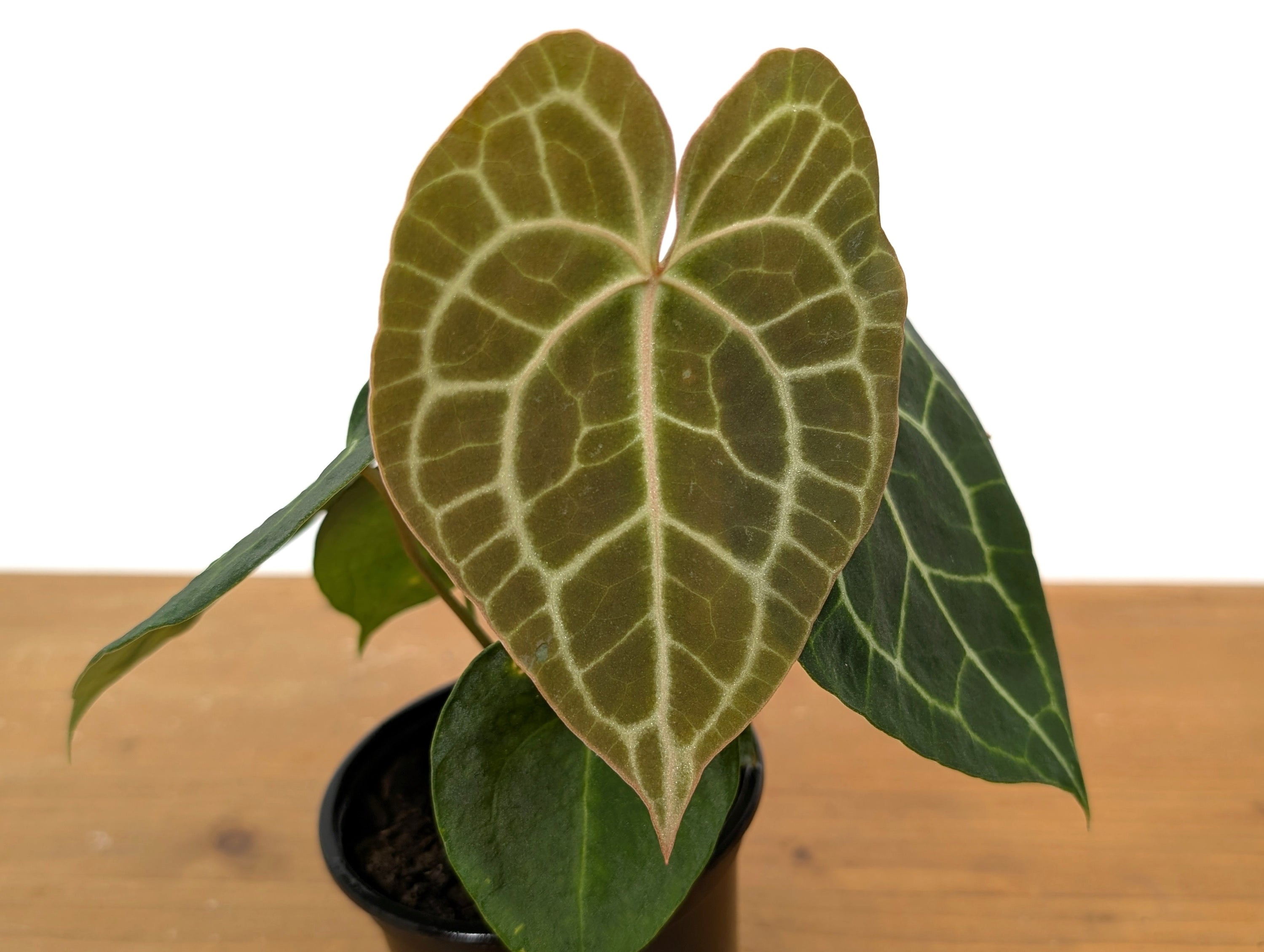General Anthurium Care
LIGHT REQUIREMENTS
The quick take: These beauties crave that "bright indirect light" sweet spot – think rainforest canopy vibes.
Ideal: A spot where they can read a book without squinting (2,000–3,000 lux)
They’ll tolerate: That slightly dimmer corner… but they’ll grow slower and give you fewer flowers like a petulant artist.
Drama alert: Direct sun = instant leaf scorch. She’s not a cactus, Karen.
Pro tip: If your Anthurium starts stretching like it’s doing yoga toward the window, it’s begging for more light. East or north-facing windows are ideal. If using artificial light, provide 12–14 hours daily.
WATERING
The Goldilocks Zone
The quick take: They want moisture without the swampy feet.
When: Poke your finger in – if the top inch feels like a day-old brownie (slightly dry), it’s time.
How: Water deeply like a tropical rainstorm until it drains out the bottom. Then LEAVE HER ALONE.
Overwatering signs: Yellow leaves, stems softer than overcooked noodles.
Underwatering signs: Leaves drooping like it just heard bad news.
Whisper: They’d rather be thirsty than drowned. When in doubt, wait a day.
HUMIDITY
The quick take: They miss their jungle steam bath.
Humidity: 60%+ or they’ll throw crispy-leaf tantrums. Bathrooms = their happy place.
Temperature: Keep it between "cozy sweater weather" and "beach vacation" (65–80°F).
Biggest ick: Drafts. They hate sudden chills more than a Floridian in January.
Hack: Cluster plants together or use a pebble tray – it’s like giving them a plant sleepover.
PRUNING
The quick take: They’re low-maintenance but appreciate a tidy-up.
Do: Snip yellow leaves at the base (no sad energy allowed).
Shine: Wipe leaves monthly – they photosynthesize better when not dusty.
Flowers: Deadhead spent blooms to redirect energy.
Fun fact: Those "flowers" are actually modified leaves (spathes). The real flowers are the tiny bumps on the spike!
Feeding your Anthurium: Don't forget their supplements
The quick take: Think of fertilizer as their iced latte – regular but not too strong.
When: Monthly spring-summer (their "gym season"), skip in winter.
What: Half-strength balanced fertilizer. Bonus points for calcium (for those glossy leaves).
Overdoing it: Salt buildup = burnt tips. Flush soil occasionally like a detox.
Whisper: They bloom more when slightly root-bound. A little stress keeps them sassy.
Common Anthurium Issues
1. "Help, my leaves are turning yellow!" 🟡
Likely Culprits:
-
Overwatering: Soggy soil = roots screaming for air. Check for mushy stems.
-
Underwatering: Crispy edges with yellow? Thirsty.
-
Old age: Lower leaves yellow and drop naturally (like retiring from their leaf job).
Fix:
-
Stick your finger in the soil. Wet? Stop watering. Bone dry? Soak it.
-
If roots are brown and slimy, it’s surgery time: trim rot, repot in fresh mix.
2. "Why are my leaf tips brown and crispy?" ☕
Usually Means:
-
Low humidity: They crave that tropical steam. Under 50% = crispy tantrums.
-
Tap water salts: Fluoride/chlorine burns tips. Use filtered or rainwater.
-
Over-fertilizing: Salt buildup fries roots. Flush soil every few months.
Fix:
-
Humidifier or pebble tray (group plants for a mini-jungle effect).
-
Water with room-temp filtered water.
3. "No flowers, just leaves!" 🌿→❌🌺
Reasons:
-
Light starvation: Anthuriums bloom best with bright, indirect light.
-
Too cozy: Slightly root-bound encourages blooms (but don’t torture them).
-
Hungry: They’re heavy feeders in growing season.
Fix:
-
Move closer to a window (but no direct sun).
-
Try a bloom-boosting fertilizer (higher phosphorus).
4. "Weird spots on my leaves!" 🔍
Check For:
-
Bacterial blight: Wet, oozy spots with yellow halos.
-
Fungal issues: Dry, crusty patches or powdery mildew.
-
Sunburn: Bleached, crispy spots where light hits directly.
Fix:
-
Isolate the plant ASAP.
-
Trim affected leaves with sterile scissors.
-
Improve airflow (a fan helps prevent fungal parties).
5. "Pests invaded!" 🐜
Common Villains:
-
Spider mites: Tiny web-weavers that suck sap (look for stippling).
-
Mealybugs: Fluffy white monsters in leaf crevices.
-
Aphids: Green or black bugs clustered on new growth.
Fix:
-
Neem oil spray: Wipe leaves top and bottom weekly.
-
Shower power: Rinse leaves to dislodge bugs.
-
Quarantine: Keep infected plants away from others!
6. "My new leaf is stuck!" 🌀
Why It Happens:
-
Low humidity: The leaf can’t unfurl without moisture.
-
Thirsty roots: Underwatering = weak leaf power.
Emergency Help:
-
Wrap the stuck leaf in a damp paper towel for 1 hour.
-
Mist gently to lubricate (don’t force it!).
7. "Leaves are small and sad" 📉
Probable Causes:
-
Not enough light: Stretching = reaching for more.
-
Hungry plant: Needs fertilizer (try worm castings).
-
Root-bound: Check if roots are circling the pot.
Fix:
-
Repot if needed (go up 1-2 inches in pot size).
-
Rotate the plant for even growth.
💡 Pro Tip: Prevention > Cure
-
Inspect weekly: Catching issues early saves headaches.
-
Keep it clean: Dust-free leaves = better photosynthesis.
-
Stay consistent: Anthuriums hate surprises (unlike your in-laws).
Remember: These plants are drama queens but resilient. A little TLC goes a long way! 🌱✨
Are Anthurium Pet Friendly?
TOXIC when ingested, keep away from pets and curious children.
